

AFWG shall not bear any responsibility for any content on such sites. Any link to a third-party site does not constitute an endorsement of the third party, their site or services. AFWG also makes no warranties as to the content of such sites.
Would you like to continue?
![]()
 Epidemiology and clinical characteristics of invasive mould infections: A multicenter, retrospective analysis in five Asian countries.
Epidemiology and clinical characteristics of invasive mould infections: A multicenter, retrospective analysis in five Asian countries.
Porpon R, Chen YC, Chakrabarti A, Li RY, Shivaprakash RM, Yu J, Kung HC, Watcharananan S, Tan AL, Saffari SE, Tan BH.
Med Mycol 2017. [Epub ahead of print].
Increasing international awareness of invasive mold infections (IMI) can be attributed to the rising number of immunocompromised people (ie, because of transplantation and chemotherapy) as well as the improvement of IMI diagnostic techniques. However, most of the literature on IMI-related statistics have come exclusively from Western centers. Data from Asian countries are rare – to date, there has been no large-scale, systematic, international study of the epidemiology of IMIs in Asia.
As such, the Asia Fungal Working Group (AFWG), a working group of the International Society for Human and Animal Mycology (ISHAM), initiated this 1-year, multicenter, retrospective study of IMIs at 5 centers in 5 countries across Asia.
The primary objective of this study was to determine the incidence and clinical determinants of IMIs in Thailand, Taiwan, Singapore, China and India; secondary objectives were to determine IMI demographics and risk factors, the types of molds responsible, physician practices in IMI management and patient outcomes.
Patients treated in one year (2012) were identified through discharge diagnoses, microbiology and histopathology logs, and were included based on published definitions of IMI. Proven or probable IMI diagnoses were based on the definitions from the European Organization for Research and Treatment of Cancer/Invasive Fungal Infections Cooperative Group and the National Institute of Allergy and Infectious Diseases Mycoses Study Group (EORTC/MSG) guidelines.
A total of 155 cases were included (median age 54 years; 47.7% male). Of these, 47.7% had proven disease; the remainder had probable IMI. IMI incidence rates varied between 0.0242 and 0.2631 per 1,000 patient-days (Table).
Table. IMI cases by country
Country | n (%) | IMI incidence per 1,000 patient-days |
Singapore | 23 (14.8) | 0.0444 |
Thailand | 66 (42.6) | 0.2621 |
China | 14 (9.0) | 0.0242 |
India | 12 (7.7) | 0.0308 |
Taiwan | 40 (25.8) | 0.0531 |
The following are other pertinent results from the study:
This is the first multicenter Asian study of IMI not limited to specific patient groups or diagnostic methods. Although the study revealed IMI incidence rates of 0.0242 and 0.2631 per 1,000 patient-days across the 5 centers, the actual burden of IMI may be higher. For instance, a third of case report forms were excluded for not meeting the EORTC/MSG criteria, among other factors.
A key finding from the current study was that DM was an important underlying condition (found in around a third of the subjects), a finding also noted in previous reports. DM was also common in patients with more ‘classical’ underlying conditions, such as hematologic malignancies, supporting the possibility that the presence of 2 or more risk factors/predisposing conditions means IMI could also occur in persons who do not meet current consensus criteria.
In the study, more than 11% of patients had an underlying rheumatologic condition, which suggests that this condition should be considered an important risk factor for IMI as well. Patients with rheumatologic conditions are usually treated with immunosuppressive agents, increasing their risk of contracting opportunistic infections, including IMIs.
In terms of radiologic investigation, the study results suggest that IMI should not be ruled out in patients with a suspected infection whose chest CT findings do not fit conventional EORTC/MSG criteria.
The 90-day mortality rate (32.9%) is an improvement over previous data. Possible factors that may have contributed to improved rates in the present series include:
Despite study limitations such as a retrospective design and short duration, this study is “a new milestone for the region”, providing valuable insight into IMIs from 5 different Asian countries. The study authors express the hope that as electronic medical records in hospitals become more sophisticated, the study may facilitate common standards in data archives and collection across hospital centers.
Reference: Porpon R, Chen YC, Chakrabarti A, Li RY, Shivaprakash RM, Yu J, Kung HC, Watcharananan S, Tan AL, Saffari SE, Tan BH. Epidemiology and clinical characteristics of invasive mould infections: A multicenter, retrospective analysis in five Asian countries. Med Mycol 2017 May 19 [Epub ahead of print].